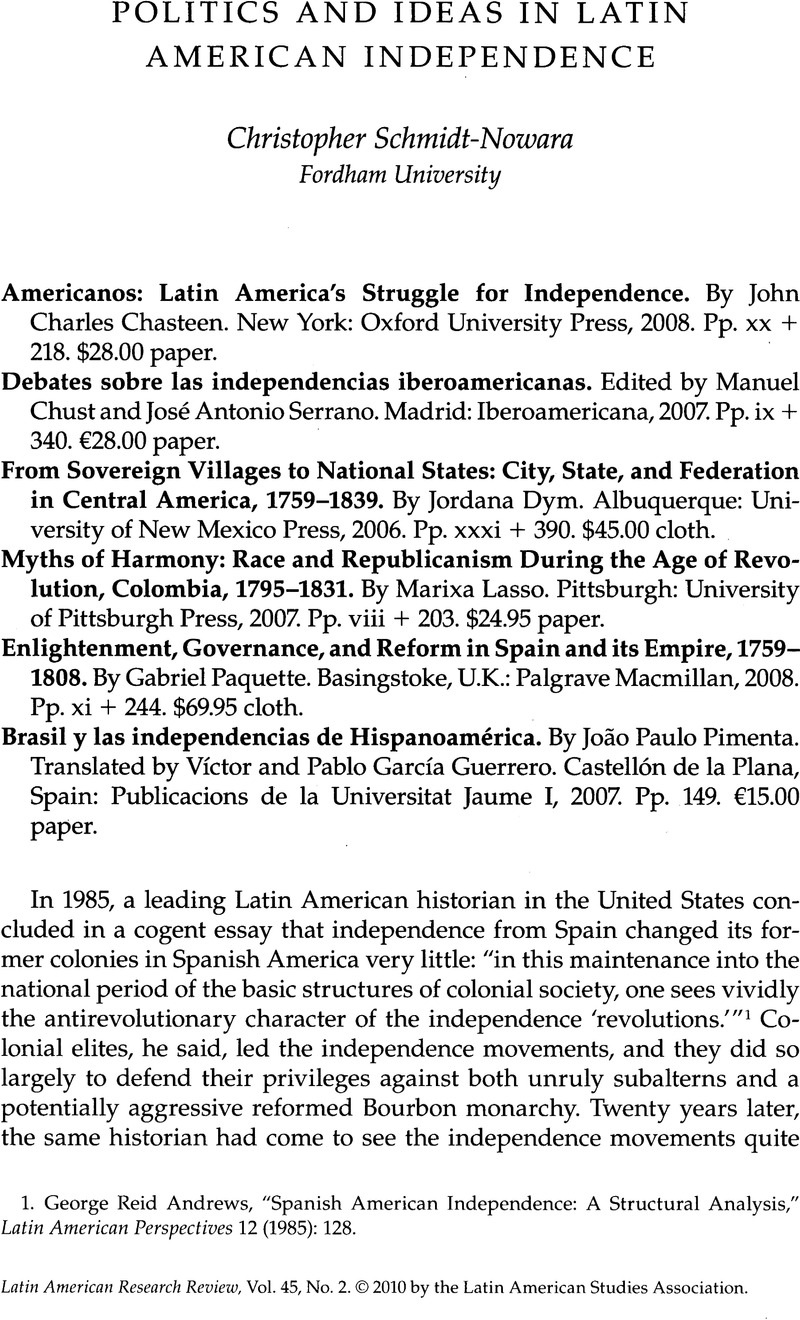No CrossRef data available.
Published online by Cambridge University Press: 05 September 2022

1. George Reid Andrews, “Spanish American Independence: A Structural Analysis,” Latin American Perspectives 12 (1985): 128.
2. George Reid Andrews, Afro-Latin America, 1800–2000 (New York: Oxford University Press, 2004), 54–55.
3. William H. Sewell Jr., “The Political Unconscious of Social and Cultural History; or, Confessions of a Former Quantitative Historian,” Logics of History: Social Theory and Social Transformation (Chicago: University of Chicago Press, 2005), 22–80.
4. Influential studies that point in this direction are David Brading, The First America: The Spanish Monarchy, Creole Patriots, and the Liberal State, 1492–1867 (New York: Cambridge University Press, 1991); François-Xavier Guerra, Modernidad e independencias: Ensayos sobre las revoluciones hispánicas (Madrid: MAPFRE, 1992); Jaime Rodríguez O., The Independence of Spanish America (New York: Cambridge University Press, 1998).
5. The discrepancy between center and periphery is a recurrent theme in John H. Elliott's works on the Habsburg era. Among other studies on Spain and Spanish America during the Bourbon reforms, see Stanley Stein and Barbara Stein, Apogee of Empire: Spain and New Spain in the Age of Charles III, 1759–1789 (Baltimore: Johns Hopkins University Press, 2003); David Weber, Bárbaros: Spaniards and Their Savages in the Age of Enlightenment (New Haven, CT: Yale University Press, 2005). Recent characterizations of other imperial regimes in comparable terms include Frederick Cooper, Colonialism in Question: Theory, Knowledge, History (Berkeley: University of California Press, 2005).
6. See Alejandro de la Fuente, with the collaboration of César García del Pino and Bernardo Iglesias Delgado, Havana and the Atlantic in the Sixteenth Century (Chapel Hill: University of North Carolina Press, 2008).
7. On slavery and the Spanish American revolutions, see Andrews, Afro-Latin America, 53–84; Peter Blanchard, Under the Flags of Freedom: Slave Soldiers and the Wars of Independence Spanish South America (Pittsburgh: University of Pittsburgh Press, 2008).
8. Ann Twinam, “Pedro de Ayarza: The Purchase of Whiteness,” in The Human Tradition in Colonial Latin America, ed. Kenneth J. Andrien (Wilmington, DE: Scholarly Resources, 2002), 194–210.
9. John Lynch, The Spanish American Revolutions, 1808–1826 (New York: Norton, 1973).
10. See John H. Elliott, Empires of the Atlantic World: Britain and Spain in America, 1492–1830 (New Haven, CT: Yale University Press, 2006), on the sturdiness of Habsburg structures and mentalities in the Indies through the eighteenth century.
11. Jeremy Adelman, Sovereignty and Revolution in the Iberian Atlantic (Princeton, NJ: Princeton University Press, 2006).
12. Luiz Felipe de Alencastro, O trato dos viventes: Formação do Brasil no Atlântico sul (São Paulo: Companhia Das Letras, 2000). See also Zephyr Frank, Dutra's World: Wealth and Family in Nineteenth-Century Rio de Janeiro (Albuquerque: University of New Mexico Press, 2004); João José Reis, Flávio dos Santos Gomes, and Marcus J. M. de Carvalho, “África e Brasil entre margens: Aventuras e desaventuras do africano Rufino José Maria, c. 1822–1853,” Estudos Afro-Asiáticos 26 (2004): 257–302; Rafael de Bivar Marqúese, “A dinâmica da escravidão no Brasil: Resistência, tráfico negreiro e alforrias, séculos XVII a XIX,” Novos Estudos 74 (2006): 107–123.
13. For overviews, see Allan Greer and Kenneth Mills, “A Catholic Atlantic,” in The Atlantic in Global History, 1500–2000, ed. Jorge Cañizares-Esguerra and Erik Seeman (Upper Saddle River, NJ: Pearson Prentice Hall, 2007), 3–19; William Christian Jr. “Catholicisms,” in Local Religion in Colonial Mexico, ed. Martin Austin Nesvig (Albuquerque: University of New Mexico Press, 2006), 259–268. On religion, monarchism, and revolution, see Eric Van Young, The Other Rebellion: Popular Violence, Ideology, and the Mexican Struggle for Independence, 1810–1821 (Stanford, CA: Stanford University Press, 2001).
14. Similar pleas are made in Laurent Dubois, “An Enslaved Enlightenment: Rethinking the Intellectual History of the French Atlantic,” Social History 31 (February 2006): 1–14; Jorge Cañizares-Esguerra, Puritan Conquistadors: Iberianizing the Atlantic, 1550–1700 (Stanford, CA: Stanford University Press, 2006), 215–234.